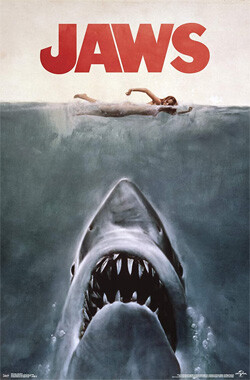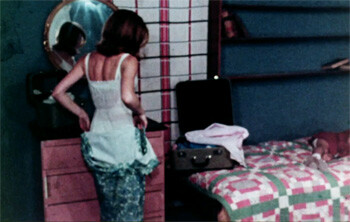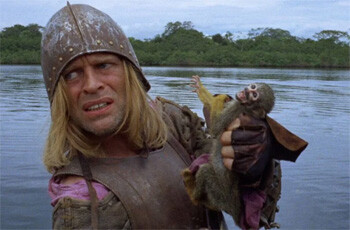4 Behind the Scenes Stories That Deserve Their Own Movie

Hollywood loves to make movies about making movies. It gives audiences a little peek behind the curtain, it gives filmmakers a chance to lampoon or lambaste their industry, plus it saves money on sets because they don't have to hide any of their equipment. The film-within-a-film genre can also be Oscar-worthy, with this past year's Mank netting 10 nominations including Best Picture, 2011's The Artist winning Best Picture, as well as Argo taking home the top honor the next year for being about a fake movie within a movie (that was also mostly fake).
However, there are some real life behind-the-scenes stories that have all of the drama, laughs, and bugnuts insanity to make a very compelling biopic one day. Such as ...
Jaws
Jaws is an iconic film that changed the way movies were made (and marketed) forever. It was the world's first summer blockbuster, it catapulted Steven Spielberg's career, the theme song is ingrained in the collective unconscious, and even after four decades it's still the number one reason people are afraid of sharks. While the film ended up being a horror classic, the making of the film was practically a comedy.

Universal Pictures
Spielberg landed the gig after the original (and unfortunately named) director Dick Richards was fired because he kept referring to the titular shark as a whale during planning meetings, and the producers felt they needed a director who at least knew the difference. The three lead actors, two of whom weren't hired until days before shooting began, hated each other. Robert Shaw hated Richard Dreyfuss which actually helped their on-screen dynamic, and Roy Scheider later described Shaw as "a perfect gentleman whenever he was sober. All he needed was one drink and then he turned into a competitive son-of-a-bitch." Yeah, let's put these three guys on a boat together and put the last half of this movie on their shoulders!
The severed arm prop on the beach at the beginning of the movie didn't look real enough, so they buried a female crew member in the sand with her arm sticking out, and in order to get the crabs to move on camera, the prop master had to splash them with hot coffee. To get the sound of actress Susan Backlinie drowning, they positioned her in front of a microphone with her head upturned and poured water down into her throat. Just to restate that, the sound guy had to waterboard an actress to get the audio right.

Universal Pictures
For the dock scene with the tiger shark, they shipped in a real shark carcass from Florida, but by the time they were ready to start filming the scene it had decomposed so badly that the unimaginable stench made it hard for the cast and crew to maintain their professionalism. At the end of that scene Lee Fierro, who played Mrs. Kitner, could not fake a slap so she hit Roy Scheider for real ... in all seventeen takes.
You rarely saw the shark in the movie because most days, there wasn't a shark to film. The platform used to tow two of the mechanical sharks capsized as it was being installed, and divers had to be dispatched to retrieve it. The animatronic sharks worked fine when they tested them in freshwater tanks, but the corrosive ocean water rendered the controls inoperable. The star of the show was turning out to be a real diva.
Famed ocean videographers Ron and Valerie Taylor were hired to shoot footage of a live great white shark off the coast of Australia for the film, and used a half-scale boat and shark cage to make the 13-foot real shark look like the 25-footer described in the movie. They used a small mannequin in a wetsuit for some shots, but when they needed the figure to move, they used a little person. What a fun casting call that must've been: "Little person needed - must be dive certified, death wish a plus."
Of the two versions of Quint's boat, the Orca, the one built to sink on cue was actually more seaworthy than the one meant to stay afloat. All of the camera and special effect rigging on the other one made it too top heavy, and the only material they could find in Martha's Vineyard that was suitable for ballast were lead x-ray vests they had to rent from a local dentist.

An accident occurred while filming on the good Orca that caused the boat to start sinking. While Spielberg screamed into a bullhorn to get lifeboats over to save the actors, sound engineer John R. Carter was standing in the sinking boat holding his recording equipment over his head screaming "F--k the actors, save the sound department!" No dice, sound guy. We heard what you did to the drowning actress.
Manos: The Hands Of Fate
When insurance and fertilizer salesman Harold P. Warren stuck up a conversation with a visiting location scout named Stirling Silliphant, it resulted in Warren making a bet that making a horror movie on his own couldn't be that hard, right? Warren ended up winning that bet, but it was the rest of the world that lost because the movie he ended up making, Manos: The Hands of Fate, is regarded as one of the worst movies ever made.

via WikiCommons
Warren managed to raise around $19,000 to produce the movie, which is roughly about $160,000 (or about one-fifth of the average indie film budget) in today's dollars. He managed to save money where he could, mainly by promising his cast and crew a percentage of the film's profits in lieu of actual wages. The only ones who actually got paid for their time were seven-year-old Jackey Neyman and her dog, who got a bicycle and a 50-pound bag of dog food, respectively.
The entire movie was filmed on a hand-wound 16mm Bell & Howell camera, which could only shoot 32 seconds of footage at a time. Since many of the film's cast and crew held day jobs, most of the film was shot at night. The lights used for filming attracted swarms of moths, but wasn't nearly as much of a distraction as the acting. Because all of the equipment was rented, Warren only did two takes of each shot so he could return the equipment on time, promising any errors could be fixed in post-production, which can't even be done in iMovie, let alone a mid-'60s film lab.

Sun City Films
They didn't even record audio on set, opting instead to dub in all dialogue and sound effects later. Of the sixteen total speaking parts in the film, the ten female characters' voices were all dubbed by one woman. There were even scenes where Warren dubbed all of the voices himself, and didn't even try to make them sound different.
During filming, Warren signed the actress Diane Mahree up for a west Texas beauty pageant without telling her, thinking that would generate publicity for the film. Warren also tried to coerce Mahree to remove her top for one scene, but quickly backpedalled on that after she was rightfully upset at the suggestion.

Sun City Films
John Reynolds, who played the satyr-like henchman Torgo in the film, was reportedly on LSD the entire shoot. Torgo's fate was left open-ended, as Warren toyed with the idea of Torgo returning for a sequel. Reynolds himself had to deal with personal demons far worse than Torgo, and wound up committing suicide a month before the film's premiere.
The premiere itself was another chance for Warren to try to give this project a veneer of legitimacy. He borrowed search lights from a local car dealership to have outside the theater. He only rented one limo, having the cast wait in the alley so the limo could pick up one group, speed around the block to drop them off at the red carpet, then speed back around to pick up the next group.

Sun City Films
Once the movie started, and the audience got an idea of how bad it was, everyone involved in the movie had to sneak out of the theater. No one went to the after party, and pretty much no one ever spoke to each other about the film again, choosing to block the entire memory of the film from their collective minds.
Nearly three decades later, when the film found its way into the hands of Mystery Science Theater 3000, Manos became a cult classic, inspiring a digital remastering of the film for DVD and BluRay, as well as fan-financed prequel and sequel films released in 2018. But seeing as Harold P. Warren failed to file a copyright on the original film, it entered the public domain right away, so any members of the cast and crew hoping to finally get their promised share of the profits were out of luck.
Tombstone And Wyatt Earp
There have been countless examples over the years of movie studios with competing projects with similar plots coming out around the same time: Deep Impact and Armageddon, Olympus Has Fallen and White House Down, Captain America: Civil War and Batman v. Superman, etc. The direct competition is good for generating buzz, which is why Hollywood keeps allowing these things to happen. But rarely have two competing film projects been intertwined quite like that of Tombstone and Wyatt Earp, the latter film having been more or less as an F-You to the former.
Kevin Costner had been attached to star in Tombstone, but left the project over creative differences with the film's original director Kevin Jarre. Jarre had planned for the film to be more of an epic ensemble piece about the lives of everyone involved with Wyatt Earp's time in Tombstone. Costner felt the film should've been focused on Earp himself, a suggestion he no doubt made while slamming his two Dances With Wolves Oscars onto the table.

Warner Bros.
After leaving the project, perhaps even on his way back to his car, Costner started to produce his own Wyatt Earp project. It was originally conceived to be a six-hour TV miniseries, but became a three-plus hour feature film instead when Costner signed on to star. The film was rushed into production and just like that, the pissing contest at the O.K. Corral was on.
While Tombstone had a little bit of head start on filming, the production was running behind schedule. Kevin Jarre was fired early on in the shoot, and the scenes he filmed were reshot after new director George P. Cosmatos took over to help whittle the story down to not have to include every citizen of Tombstone. Star Kurt Russell has since admitted that he secretly directed the film while Cosmatos was there merely to keep the production on track, marking one of the rare times a film set had a shadow government.

Buena Vista Pictures
The filmmakers wanted Tombstone to look as authentic as possible, so they acquired every period accurate costume available in the entire southwest U.S. This may have helped the film look more authentic, but the idea backfired a bit because all of the costumes were made of wool, and they were filming in Arizona in the middle of the summer. This move also caused production delays for Wyatt Earp because they ended up having to import their costumes from Europe before they could start filming.
From the start, Costner was trying to torpedo Tombstone's chances by using his Oscar clout to convince most of the major studios not to distribute that film. This affected Tombstone's casting, as they had to sign on bigger names to get the studios back on board. The studios didn't hold Costner's project to the same standard, which is why Tombstone had Bill Paxton and Wyatt Earp had Bill Pullman.

Warner Bros., Buena Vista Pictures
Tombstone ended up winning in nearly every way. It wrapped up filming four months earlier than Wyatt Earp, got released to theaters six months sooner, got better reviews, and earned twice its budget at the box office while Earp bombed and bombed hard. Not to say Wyatt Earp is a bad film, it's just that no film's production could be motivated by this much spite without having some of that self-indulgence appear on screen. As Roger Ebert stated his review, "Wyatt Earp plays as if they took Tombstone and pumped it full of hot air."
Aguirre, The Wrath Of God
As a filmmaker, Werner Herzog is a genre unto himself. With over 70 feature films and documentaries over a fifty-year career, his work often explores humanity's desire for the sublime in the face of an indifferent universe. You can't go into a Herzog film expecting any answers, but you will definitely leave with much deeper questions. For a filmmaker to pull that off as prolifically as he has, it requires a very specific level of discipline.

In 1971, when Herzog was writing the screenplay for Aguirre, the Wrath of God, he wrote the lead role with one actor in mind, Klaus Kinski, a man who had rented a room in his parents' apartment when Herzog was 13. Kinski's erratic, explosive behavior left an impression on the young Herzog, particularly the time Kinski had locked himself in the communal bathroom for two days and only emerged when there was nothing left in there to destroy.
Kinski was, without hyperbole, a psychopath. As a stage actor, he often performed in one-man shows because no other actors wanted to work with him. On film sets, having to do more than one or two takes would send him into a blind rage. After being sent the screenplay for Aguirre, Kinski called up Herzog at 3am, screaming incoherently for an hour before Herzog could decipher that he loved the script.

Werner Herzog Filmproduktion
Herzog frequently butted heads with Kinski over how the character of Aguirre should be played. Kinski, naturally, wanted to play him as a full-tilt maniac, while Herzog wanted something more quiet and menacing. Herzog got his way, but only by deliberately pissing off Kinski before each shot and filming after his hissy fit had worn him out.
The film was shot in chronological order, thinking that the cast's progress through the jungles and rivers of Peru would enhance their characters' weariness as the story advanced. Kinski's behavior definitely accelerated that weariness. The native extras particularly despised him, with one of the native chiefs reportedly making Herzog a sincere offer to kill Kinski on his behalf. The offer was refused, mainly because getting another actor to replace him would be too much of a hassle.

Werner Herzog Filmproduktion
One night after filming had wrapped for the day, some of the cast and crew were having themselves a party when Kinski, irritated by the noise, started firing a rifle at their hut. One of the bullets took off the tip of an extra's finger, which thankfully was the only injury. Herzog took the rifle away from Kinski, and has kept it to this day.
After Herzog refused to fire a sound assistant that Kinski had a problem with, Kinski threatened to quit the project. Herzog countered by threatening to kill Kinski and turn the gun on himself if he tried to leave. Kinski got back in line real quick, because when an artist like Werner F---ing Herzog gives you a choice between finishing the movie or a murder-suicide, he's not bluffing.
Despite all this insanity, Herzog and Kinski worked together four more times after Aguirre, The Wrath of God, even returning to jungles of Peru for Fitzcarraldo. In 1999, Herzog released My Best Fiend, a documentary about their relationship. As he once said about Kinski, "People think we had a love-hate relationship. Well, I did not love him, nor did I hate him. We had mutual respect for each other, even as we both planned each other's murder."